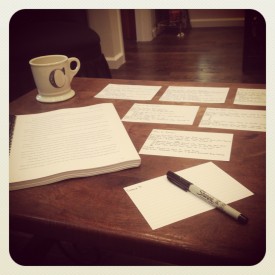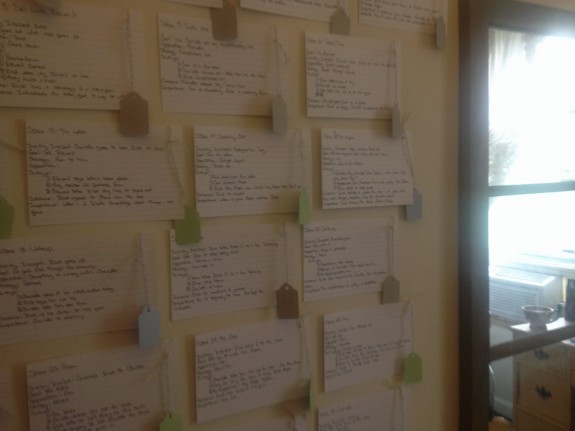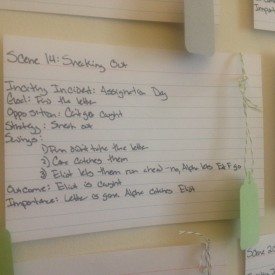This is the fifth and final post in my series on the benefits of writing with an outline. In my first post, I listed three reasons why most writers need an outline. In the second, I discussed three things to keep in mind when creating an outline. In the third, I talked about how to use one while drafting. In the fourth, I got into the nuts and bolts of different types of outlines. In this final post, we’ll be talking about one of the best ways to use your outline as a physical writing tool.
Do you ever feel like all you do is stare at a computer? Writers spend hours in front of a computer, and many writers have dayjobs that also require them to be staring at a screen. Even if it’s not at work, we’re staring at phones. At tablets. At E-readers. This is not only a strain on the eyes, but it can be a strain on the brain, too. Sometimes, it’s good to step away from the screen.
In my writing group, we have cultivated a practice we call “Craft Time.” It’s a chance to step away from the words on the screen and look at paper. Like, actual paper. Getting away from your manuscript file can help you look at it in a new way. Sometimes, it’s just to write by hand, or to read a printed-out version. But often, for me, this is the perfect time to outline. But Bess, you may be asking, why do I need a physical copy of an outline I’ve already got on my computer? Well, that’s a good question. Here’s three reasons why creating a physical outline will make your life easier:
1) Writing by Hand is Awesome
There are lots of theories, I’m sure, about whether or not it’s good to write by hand, on a typewriter or on a computer. Pen versus pencil. Paper versus notebook. Certainly, you can write faster on a computer. But outlining isn’t about massive output. It’s about thinking things through. There’s no doubt that writing by hand forces you to slow down. It makes you think twice about what you’re writing, because you don’t want to write it again. Writing down your outline, even if you already have it on your computer, is a great way to fine tune it.
2) The Internet is Awesome
And often a huge distraction. When you’re writing on an actual piece of paper, that piece of paper does not have a little glowing icon that will let you go read the latest tweets of your favorite author, the latest news on your favorite politician or the latest cat pictures from your favorite Facebook friend. Outlining forces you to think about the big picture of your book–to see it as a whole, and to break that whole down into parts. This is a lot easier to do when there’s nothing to distract you from it.
3) Visuals Are Awesome
This is the fun part. When you make an outline by hand, you can design it, so that it can continue to do its job–forcing you to think about your whole book. Instead of just writing your outline on a piece of paper, write it on note-cards. A card for each scene. And then put it on the wall. You’ll have a visual representation of your book that you can adjust as your book changes. Not only does the act of making it get you away from the screen and into thinking about your book, but when you’re done you’ll have a powerful tool that you can continue to use as you draft and revise.
Here’s a picture of an outline I did for my last book.

I created a note-card for each major scene, with the following information:
- Scene Name

- Inciting Incident
- Main Character’s Goal
- Main Character’s Opposition
- His Strategy
- Swings
- Outcome
- Importance
This was on my second draft, so I already had a good idea of the overall plot, and was getting into the nuts and bolts of making each scene matter. Depending on the type of outline you want to make, these cards will change. For a first draft, you might just write down what your character wants and opposition. Or, if you’re more of a pantser, you might write very little. Just “Adam goes to the fountain to meet Eliza,” and see where the characters go next. But having something in concrete form will help focus your mind, even if you start out with just three cards — Beginning, middle and End. You’re going somewhere, and sometimes that’s all you need.
Make Your Outline Work for You
There are so many ways you can use a note-card outline once you’ve created it. If you have multiple view-points, try color-coding. Make each character a different colored note-card. When you’ve completed your outline, you’ll be able to see if one character has too much page-time, or if another has too little. One thing I like to do is color-code according to the amount of revision needed on a scene.

I added little flags in different colors. Grey meant the scene was finished. Blue meant it needed some work, and green meant it needed a lot of work. At the beginning of my revision, there was a lot of green! Revising a book can feel endless. Sometimes you can work on a scene for days, and feel like you haven’t accomplished anything. It’s different from drafting, where you’ve got the concrete satisfaction of a growing word count. But using a color-coded outline is a little trick you can play on your own brain. I found myself looking forward to switching a green flag to blue, and then a blue flag to grey. I also found myself looking at each scene critically, making sure it was necessary, and understanding where it fit in with the book as a whole.
The beauty of an outline is that it can be both a challenge and a tool, and that you can make it work for your story and writing style. Do you outline? Have you found another method that works for you? Let me know in the comments!
 Bess Cozby writes epic stories in expansive worlds from her tiny apartment in New York City. By day, she’s an Editor at Tor Books, and Web Editor for DIY MFA. Her work is represented by Brooks Sherman of the Bent Agency. Tweet her at @besscozby, contact her at bess@diymfa.com, or visit her website at www.besscozby.com.
Bess Cozby writes epic stories in expansive worlds from her tiny apartment in New York City. By day, she’s an Editor at Tor Books, and Web Editor for DIY MFA. Her work is represented by Brooks Sherman of the Bent Agency. Tweet her at @besscozby, contact her at bess@diymfa.com, or visit her website at www.besscozby.com.






